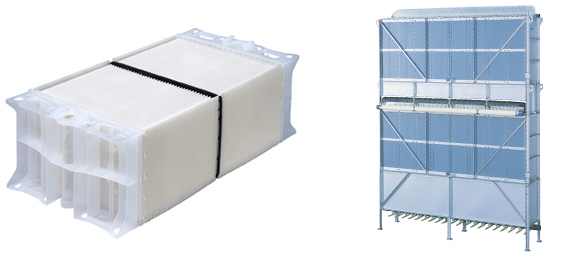
Product Highlight: KUBOTA Submerged Membrane Unit ®
Kubota Membrane USA provides a world-class membrane bioreactor (MBR) wastewater treatment system based on the innovative Kubota flat sheet membrane. There are over 4,500 installations of the Kubota system worldwide. That unparalleled experience has provided the Kubota Corporation the knowledge to engineer the system to meet nearly any configuration and application.
What is a Membrane Bioreactor?
A membrane bioreactor (MBR) integrates a membrane process, like microfiltration or ultrafiltration, with a biological process, a suspended growth bioreactor.
The membrane is simply a two-dimensional material that serves as a filter, separating the solids on the basis of their size or electrical charge. The bioreactor is a system contained within a vessel that supports a biologically active environment. The biological process first creates the solids, which are then filtered by the membrane resulting in a clarified and disinfected effluent. The membranes can either be submerged within the bioreactor or housed externally to the reactor.
What are the benefits of the Kubota Submerged MBR?
The process is similar to the conventional activated sludge system, but an MBR differs in that it uses a membrane rather than a secondary clarifier or settlement tank for solid separation. The MBR provides a number of advantages relating to process control and product water quality.
- Uncoupling HRT and SRT: a significant advantage of the membrane bioreactor process is that the sludge solids are completely retained in the bioreactor. This means the solids retention time (SRT) in the bioreactor can be completely controlled separately from the hydraulic retention time (HRT).
- High quality effluent: The small pore size of the membrane means that the treated effluent is of very high clarity and significantly reduced pathogen concentration. MBR processes provide a substantially clarified and disinfected effluent of high enough quality to be discharged to sensitive receiving bodies or to be reclaimed for applications such as urban irrigation, utilities or toilet flushing.
- Small footprint: Increased concentrations mean that the same total mass of solids is contained in a smaller volume, such that the footprint is smaller.
- Better treatment: longer solids retention times tend to provide better treatment overall because the conditions encourage the development of the slower-growing microorganisms, specifically nitrifiers. MBRs are especially effective at the biological removal of ammonia (‘nitrification’).

Source: THE MBR SITE; http://www.thembrsite.com/about-mbrs/what-are-mbrs/